The Democratic Republic of Congo has welcomed back 112 African Grey parrots in a landmark moment in the fight to end trafficking of parrots in the region. Grey parrots, are classified as Endangered, have been captured in the wild in enormous numbers to supply the exotic pet trade. The parrots were part of a group of 309 wild parrots (of which 252 were African Greys) seized in Turkey on route to Iraq, Kuwait and Thailand and had been concealed within containers along with Red-fronted parrots which can still be legally traded under current international agreements.

After being intercepted by Turkish officials, the parrots were transferred to a wildlife park in Turkey. Soon after the confiscation, officials from the Turkish and Congolese CITES Management Authorities, supported by wildlife conservation organisations including the World Parrot Trust, began planning how the parrots could be brought home. A major hurdle in the repatriation was overcome when Turkish Airlines, the airline which had been used to traffic the parrots, agreed to fly the parrots back to Kinshasa free of charge. Turkish Airlines and WPT are members of the United for Wildlife programme under the Royal Foundation of the Prince and Princess of Wales, which works across the transport sector to tackle wildlife trafficking. The World Parrot Trust liaised with Turkish Airlines following the seizure to discuss the repatriation of the parrots and is committed to working with United for Wildlife and Turkish Airlines to develop measures to tackle the trafficking of Grey parrots. Previous investigations by WPT have revealed how Turkish Airlines is used by parrot traffickers.
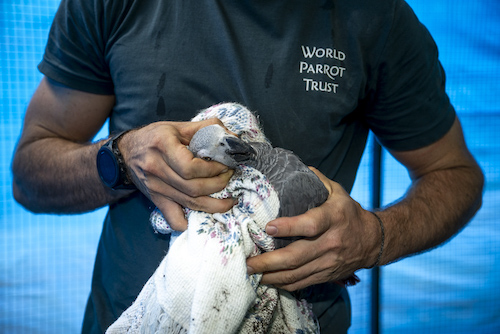
On arrival in Kinshasa, the parrots were temporarily housed and taken care of in the Jardin Zoologique in Kinshasa before flying onwards to Kindu in Maniema Province. Dr. Steven Janssen, an experienced wildlife veterinarian and the World Parrot Trust’s Wild Parrot Care Coordinator, travelled to Kinshasa to assist in the care for the parrots, conduct health checks and oversee their transport. Following their arrival in Kindu the parrots are being cared for at the Dingi Parrot Conservation Centre, part of the Projet de Protection des Perroquets (P3C) implemented by the Lukuru Foundation and founded with WPT support. In October and November Dr. Janssen visited the P3C to deliver training and capacity building in the management and care of parrots being received by the project. New aviaries are being built to accommodate this latest group. Following quarantine, health assessments and the final stages of their rehabilitation, it is hoped that the majority can be released back into the wild to restore populations in the Lomami National Park.
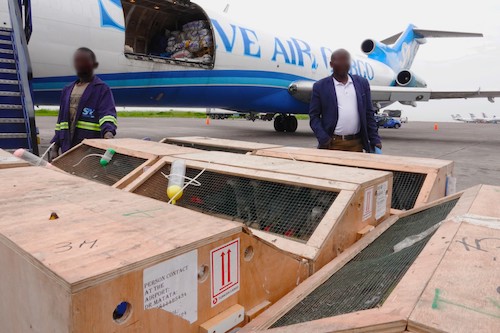
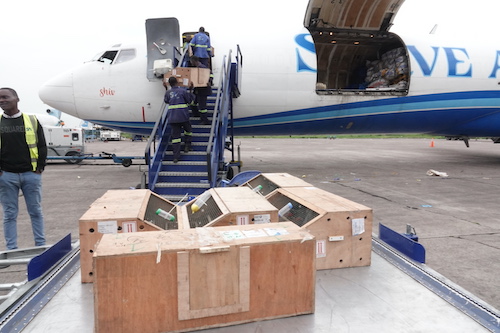
“This was an incredible team effort by many people and organisations, not least the team working with the Lukuru Foundation, who showed impressive dedication to getting these parrots home throughout. We’re hugely grateful to the ICCN, the Turkish Management Authority, Turkish Airlines, the Jardin Zoologique in Kinshasa and the many other individuals and organisations who all played a role. There were sleepless nights and very long days but seeing these parrots arrive in Kindu and knowing that they will one day soon be flying free again has made it all worth it.” explained Dr Janssen.
The excitement surrounding the return of the parrots attracted the attention of the media including coverage on national TV and the radio.
This repatriation also sends a strong message to people involved in illegal wildlife trade. Speaking to the press, Radar Nshuli, of the Institute Congolais pour la Conservation de la Nature (ICCN) said ”These parrots may have escaped control at our airports, but they have been stopped in Turkey and now they are back in DRC. We want people to know that when it comes to protected species, no matter where you go, you will be stopped. We will track down all of those who destroy our nature.”
In a press release statement the Director General of the ICCN, Yves Milan Ngangay, confirmed that the accused traffickers had been brought before the courts, which is continuing to investigate the case and that criminals would face the full rigour of the law.
Photo Credits: Steven Janssen and Robert J Ross.
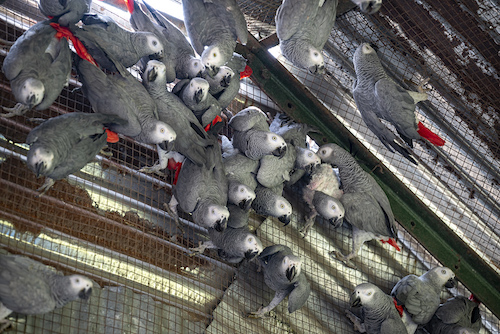
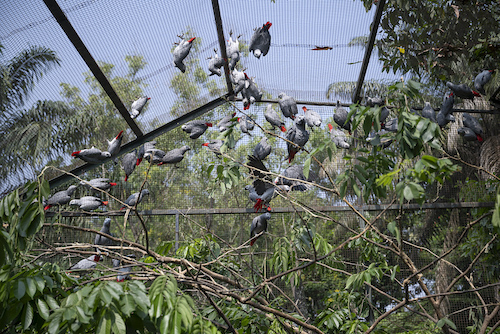
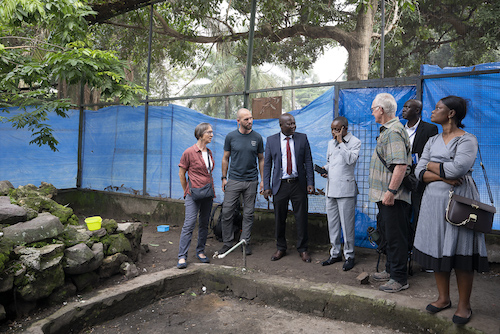
Minister of Environment from Maniema province (in the middle) visits the aviary at Kinshasa Zoo.
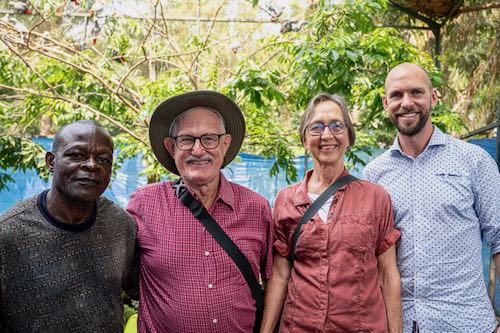
From L to R: Pétillon (zoo keeper, resp. for parrots), John Hart and Terese Hart from P3C and Steven Janssen from WPT
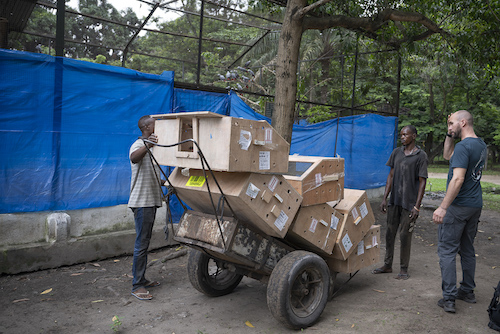
by: Sascha Dueker, WPT Lovebird Conservation Coordinator
A new roadmap to boost lovebird conservation:
We received exciting news from the African Lovebird research front: the scientific conservation review paper (Dueker et al. 2023) has now been published by the leading South African journal Ostrich, which is a major step forward in the work being done for these charismatic birds in the wild. Writing the paper has ever been a priority by the Parrot Researchers Group (PRG) after the review on larger African parrots was published earlier (Martin et al. 2014).

Read the paper online: https://doi.org/10.2989/00306525.2023.2206674

Fig. 1 showing the distribution of the 9 different lovebird species.
Lovebirds are a group of small, colourful parrots, two-thirds of which are considered to have declining populations, that are endemic to sub-Saharan Africa and Madagascar. This new scientific paper will provide a much-needed boost for the conservation and research of lovebirds highlighting the most important knowledge gaps. The paper combines expert knowledge with an extensive review of primary and grey literature to identify what is known and what we need to find out to better conserve this group of birds. The research highlighted how published studies were largely concentrated on lovebird populations in Southern Africa and, to a lesser extent, East Africa. As a result, many species remain poorly studied in the wild, including well-known companion lovebirds such as the Fischer’s Lovebird (Agapornis fischeri) and the Masked Lovebird (Agapornis personatus). For some species, such as the Black-collared Lovebird (A. swindernianus) there is a paucity of even basic information, such as geo-referenced records of presence in much of their presumed range.
The paper also considers what is known about threats in the wild, highlighting how lovebirds have historically been taken from the wild in large numbers for the international pet trade, leading to population declines. Although the trade in wild lovebirds has been greatly reduced compared to historical levels, considerable numbers are still being captured for local and international trade without any monitoring of the wild populations. In recent years Madagascar has issued permits to export thousands of wild Grey-headed lovebirds (A. canus) for commercial trade. Habitat change is also playing a role in population declines, particularly among species considered to be habitat specialists such as the Nyasa, or Lilian’s Lovebird (A. lilianae) and the Black-cheeked Lovebird (A. nigrigenis). However, changing habitat has also driven range expansions and, in combination with trade, has created numerous novel contact zones between species that were formerly divided by natural barriers such as vegetation. Hybridisation has been widely reported, particularly in East Africa, and studies on the implications of this for conservation are urgently needed.

Fig. 2 (images a-h) showing different threats to lovebirds from logging of roosting and breeding trees over capture for the pet trade and hybridization.
The studies’ 19 authors who come from across the African continent and beyond call for more targeted research on lovebirds to inform assessments of their population trends, understand the drivers of these trends and highlight opportunities to leverage existing data and new research tools to advance knowledge to support their conservation. We hope this new scientific paper will be a significant step forward in understanding the conservation needs of lovebirds and be a catalyst for many new initiatives to help protect and preserve these special birds.
Reference
Sascha Dueker, Sandi Willows-Munro, Michael R Perrin, Yilma D Abebe, Nathaniel ND Annorbah, Esther W Mwangi, Ireene R Madindou, Wondimagegnehu Tekalign, Emiliano Mori, Tiwonge I Mzumara, Chris Brown, Ursula Bryson, Henry Ndithia, Tim Dodman, Henriette van der Zwan, Rencia van der Sluis, Chaona R Phiri, Abigail Karimanzira & Rowan O Martin (2023) Conservation status and threats to lovebirds: knowledge gaps and research priorities, Ostrich, 94:1, 1-27, DOI: 10.2989/00306525.2023.2206674

